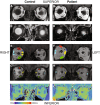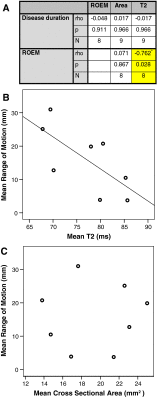Extra-ocular muscle MRI in genetically-defined mitochondrial disease
- PMID: 25994195
- PMCID: PMC4666274
- DOI: 10.1007/s00330-015-3801-5
Extra-ocular muscle MRI in genetically-defined mitochondrial disease
Abstract
Objectives: Conventional and quantitative MRI was performed in patients with chronic progressive external ophthalmoplegia (CPEO), a common manifestation of mitochondrial disease, to characterise MRI findings in the extra-ocular muscles (EOMs) and investigate whether quantitative MRI provides clinically relevant measures of disease.
Methods: Patients with CPEO due to single mitochondrial DNA deletions were compared with controls. Range of eye movement (ROEM) measurements, peri-orbital 3 T MRI T1-weighted (T1w) and short-tau-inversion-recovery (STIR) images, and T2 relaxation time maps were obtained. Blinded observers graded muscle atrophy and T1w/STIR hyperintensity. Cross-sectional areas and EOM mean T2s were recorded and correlated with clinical parameters.
Results: Nine patients and nine healthy controls were examined. Patients had reduced ROEM (patients 13.3°, controls 49.3°, p < 0.001), greater mean atrophy score and increased T1w hyperintensities. EOM mean cross-sectional area was 43 % of controls and mean T2s were prolonged (patients 75.6 ± 7.0 ms, controls 55.2 ± 4.1 ms, p < 0.001). ROEM correlated negatively with EOM T2 (rho = -0.89, p < 0.01), whilst cross-sectional area failed to correlate with any clinical measures.
Conclusions: MRI demonstrates EOM atrophy, characteristic signal changes and prolonged T2 in CPEO. Correlation between elevated EOM T2 and ROEM impairment represents a potential measure of disease severity that warrants further evaluation.
Key points: Chronic progressive external ophthalmoplegia is a common clinical manifestation of mitochondrial disease. • Existing extra-ocular muscle MRI data in CPEO reports variable radiological findings. MRI confirmed EOM atrophy and characteristic signal changes in CPEO. EOM T2 was significantly elevated in CPEO and correlated negatively with ocular movements. EOM T2 represents a potential quantitative measure of disease severity in CPEO.
Keywords: Chronic progressive external ophthalmoplegia; Kearns-Sayre syndrome; Magnetic resonance imaging; Mitochondrial DNA; Mitochondrial diseases.
Figures



References
-
- Pitceathly RDS, McFarland R (2014) Mitochondrial myopathies in adults and children: management and therapy development. Curr Opin Neurol 27(5):576–82 - PubMed
-
- Peters S, Vorgerd M, Heyer CM. Chronic progressive external ophthalmoplegia plus: diagnosis with muscular magnetic resonance tomography. Röfo. 2006;178(10):1030–1032. - PubMed
Publication types
MeSH terms
Grants and funding
LinkOut - more resources
Full Text Sources
Other Literature Sources
Medical

